Tree Climber Crushed by Falling Tree Section
 |
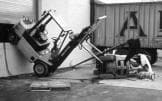 |
February 26, 2002
Investigation: # 01-NJ-055
On June 4, 2001, a 24-year-old tree trimmer was killed when the tree to which he was secured fractured beneath him and fell to the ground. Since he was tied to the tree with his lanyard, he fell with the broken section, and was crushed under it.
NJ FACE staff concluded that, to prevent similar incidents, the following safety guidelines should be followed:
- The employer should assess each job for safety hazards and design a work plan that addresses methods of dealing with the hazards during the tree service process.
- The employer should conduct a job briefing, based on the work plan, before starting each job.
- All safety equipment should be inspected for damage before each job. Any damaged equipment should be removed from service and replaced with equipment that conforms to ANSI Z133.1.
- The employer should establish a written safety and health policy and written company operational policies that include ANSI Z133.1.
- Employers and employees should become familiar with available resources on safety standards and safe work practices.
INTRODUCTION
A federal OSHA compliance officer informed the FACE staff about this work-related fatal injury on June 7, 2001. The FACE investigation was initiated concurrently with an OSHA inspection on June 18, 2001, and the victim’s co-workers were interviewed. The company did not respond to a letter and several phone messages requesting an interview. A visit to the incident site was conducted on June 20, 2001. The victim’s climbing saddle and rope were observed at the federal OSHA office. Additional information was received from the county medical examiner’s reports, police report, federal OSHA, and a New Jersey master arborist.
The employer was a tree service company that had been in business for six years and employed six workers. The owners belonged to no professional or trade associations; there is no information about the source of their arboriculture training. The company had no written safety program; all training was on-the-job. The tree work was done from the ground or while positioned in the trees. The company owned no aerial lifts or cranes but was reported to have leased lifting equipment at times. The owners met with the customers and estimated the cost of the jobs. They provided climbing gear for the workers.
INVESTIGATION
The tree service crew consisted of a supervisor, two climbers, and a groundsman. The victim had been with the company for four years and was their lead tree climber. A second tree climber had been with the company for three months and reported that he had been trained by a large tree service company about six years prior to the incident. The groundsman had been employed for three months. The crew’s supervisor (who did not climb) had been employed for two years. The victim’s training was on-the-job.
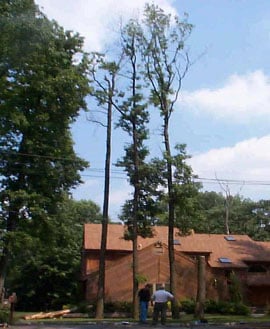
The site of the incident was the front yard of a single-family home in a suburban area that was surrounded by many tall trees. Four sweet gum trees, approximately 65 feet tall, grew from 2 ½ to 5 feet apart in front of the house, at the left of the property. The tree involved in the fatality (tree # 1, at the far right in the photo) had extensive rot at its base, fungi growing on the tree, peeling tree bark, and no foliage. Tree # 2 had multiple branches with foliage, mostly near the top section of the tree. There was a 4 inch by 6 inch area of rot at its base. Tree # 3 had foliage and no visible rot. Tree # 4 (at the far left in the photo), also to be removed, displayed areas of rot. All of the trees were in a state of decline, including those with foliage.
A utility pole bearing three transformers was located at the right of the house, near the edge of the street. A three-phase primary power line carrying 7,620 KV in each phase ran from the pole. The power line was 29 feet high and located less than six feet from the closest tree. Two other utility lines were located lower on the same pole. Electric lines servicing the house were located underground.
The tree service company had been hired by the home owner to remove two of the trees in the front yard and a tree in the back yard. The crew had started work at 8:00 a.m. and spent the morning at another job. They arrived at the incident site after lunch, at approximately 1:30 p.m. An owner of the company arrived at the site after the crew had started working. At that time the victim was in tree # 1. The day was clear and sunny with a temperature of 70 degrees.
According to the workers, they arrived at the site and observed four trees at the front of the house, two dying and two alive but in poor condition. The groundsman prepared the chain saws, assisted with the ladder, and helped the climbers with getting their equipment out of the truck and ready to use. The climbers discussed the job and how they would take down the trees. They decided to make a notch (face) cut and then “timber hitch” the tree. They planned to do this by tying a rope around the trunk, both above and below the face cut, using timber hitch knots. The climber would then make a second cut, a back cut, of the trunk. As the cut section would fall, the rope would hold it and prevent it from falling freely. The victim wore a climbing saddle to which was attached his chain saw, and climbing spurs. He carried a lanyard to attach himself to the tree. Using an aluminum extension ladder placed against tree # 1, he climbed the ladder to inspect the tree. He decided not to climb the tree, but instead to tie his line into tree # 2 and swing over to the adjacent tree #1 to take it down in sections. The two climbers were apparently reluctant to climb the trees.
The victim (the climber) used the ladder to ascend tree # 2 and then continued climbing, using his spurs. He looped a rope once around tree # 2. The ladder was removed and he then swung over to tree # 1, climbed it (spike marks started at 27 feet from the ground) and secured himself to the tree with his lanyard. He was approximately 44 feet above the ground. Using his chain saw, the climber made a notch cut into the tree trunk and instructed the groundsman to send up the pull line, or lowering line, used to lower limbs and parts of trees to the ground. The climber tied the pull line around the tree, using a timber hitch. He had no independent safety line although extra rope was available. The groundsman wrapped the opposite end of the pull line around the trunk of tree # 2 and held the line taut. He pulled on the line and watched the climber.
When the victim made the back cut, the top section of the tree fell away. The middle section of the tree then fractured 12 feet, 9 inches from the ground, at what may have been the driest and weakest section of the trunk. The break occurred below where the climber was tied (see pages 9 and 10). His co-workers heard a loud cracking sound and watched as he fell with the tree section. It landed on him and crushed him. They rushed to him and manually lifted the tree off of him. The company owner called for help by dialing 911. The victim was transported to the nearest hospital by emergency medical services where he was pronounced dead 25 minutes after the police received the call for assistance.
It is not known exactly what caused the fracture but there are two possible causes: First, instead of breaking free, the top section of the tree may have swung down and against the lower part of the trunk, as if on a hinge. The force of the cut section impacting with the standing trunk may have caused the tree to fracture. Or, second, when the climber made the back cut, the top section of the tree fell until the timber hitch caught and halted its descent. The stress of the force on the rope may have caused a kick back and the remaining portion of the tree trunk to fracture.
RECOMMENDATIONS/DISCUSSION
Recommendation #1: The employer should assess each job for safety hazards and design a work plan that addresses methods of dealing with the hazards during the tree service process.
Discussion: When estimating the cost of the job for the customer, and before assigning work, a qualified (experienced) tree worker should visually inspect the tree and it’s environment to determine if the tree is safe to climb and/or withstand forces exerted by rigging operations. The inspection is done to assess hazards, including environmental, and adapt climbing and work techniques to reduce hazards and ensure safety. Based on the inspection, the employer or supervisor should create a work plan for the employees. This job site contained at least two important hazards: proximity to overhead power lines and hazardous trees due to tree rot.
Proximity to power lines: The overhead primary power lines were less than six feet from the trees to be climbed and removed. According to the ANSI Z133.1-2000, Section 5.2, Working in Proximity to Electrical Hazards (see attachment), “only a qualified line-clearance arborist or trainee shall be assigned to work where an electrical hazard exists.” None of the tree climbers or their employers was certified as a line-clearance arborist. The New Jersey High Voltage Proximity Act (see attachment) also prohibits employers from allowing or instructing workers to participate in any activity or use equipment within six feet of a high-voltage line. The crew used an aluminum extension ladder, a conductor of electricity, to gain access to the trees.
The company could have handled this situation in several ways: 1) They could have declined to accept the job because none of the employees were skilled in line clearance and because they lacked the appropriate equipment to handle tree work so close to power lines. 2) They could have requested that the utility company de-energize the lines. 3) The employer could have contracted with a line-clearance arborist to do this work. The contracted company could have completed trimming the trees in proximity to the power lines and left the remainder of the job for them to complete, with no threat of potential electrocution.
Hazardous trees: Signs of decay were visible in three of the trees; all of the trees were in a state of decline. Growth of fungi, peeling bark, and areas that visibly looked like tree rot all indicated
that the trees were unsafe to climb. If the first hazard of proximity to electrical lines could have
been resolved (by the lines being deenergized), the company could have safely completed the job by having the employees work from an aerial lift. This would have eliminated the need to climb the trees. After designing a work plan to ensure appropriate communication and that employees would not be in the drop zone, the tree could have been taken down by cutting away sections of the top of the tree and allowing them to fall to the ground
Recommendation #2: The employer should conduct a job briefing, based on the work plan, before starting each job.
Discussion: The tree service crew and supervisor talked about the job before starting work but did not discuss the proximity to the overhead power lines or recognize the dangers of climbing unhealthy trees. ANSI Z133.1 (Revision – October 2000), section 4.1.2, states: “A job briefing, work procedure, and assignment shall be worked out carefully before any job is begun.” The job briefing should be based on the work plan and should include a description of the work to be done, the environmental and safety hazards of the job including definition of the work zone, job descriptions, and methods of communication between tree trimmers and the ground personnel. The work plan should be devised prior to the work day so it is clear how the tree work will be done and necessary equipment obtained.
Recommendation # 3: The employer should establish a written safety and health policy and written company operational policies that include ANSI Z133.1.
Discussion: Although the company had only six employees, the safety and health policies should be in writing. Company operational policies should also be written. Having policies in writing fosters consistency and makes rules and standards clear to all workers.
A written safety and health policy would include organized training and education of workers. ANSI Z133.1 (Revision – October 2000), section 4.1.2, states “Employers shall instruct their employees in the proper use, inspection and maintenance of tools and equipment, including ropes and lines, and shall require that safe appropriate working practices be followed.”
Recommendation # 4: All safety equipment should be inspected for damage before each job. Any damaged equipment should be removed from service and replaced with equipment that conforms to ANSI Z133.1.
Discussion: The climber’s rope was noted to be frayed and contained burn marks, possibly from friction. All lines and safety equipment should be inspected prior to climbing. The frayed rope should have been taken out of service and replaced with a new one to ensure safety. Extra rope was available at the work site.
Recommendation # 5: Employers and employees should become familiar with available resources on safety standards and safe work practices.
Discussion: Sources of information on occupational safety and health and information specific to arboriculture include:
U.S. Department of Labor, OSHA
Federal OSHA will provide information on safety and health standards on request. OSHA has several offices in New Jersey that cover the following counties:
Hunterdon, Middlesex, Somerset, Union, and Warren counties
Telephone: (732) 750-3270
Essex, Hudson, Morris, and Sussex counties
Telephone: (973) 263-1003
Bergen and Passaic counties
Telephone: (201) 288-1700
Atlantic, Burlington, Cape May, Camden, Cumberland, Gloucester, Mercer, Monmouth, Ocean, and Salem counties
Telephone: (856) 757-5181
Federal OSHA
Website: www.osha.govexternal icon
NJ Public Employees Occupational Safety and Health (PEOSH) Program
The PEOSH act covers all NJ state, county, and municipal employees. Two state departments administer the act; the NJ Department of Labor (NJDOL) which investigates safety hazards, and the NJ Department of Health and Senior Services (NJDHSS) which investigates health hazards. PEOSH has information that may also benefit private employers. Their telephone numbers are:
NJDOL, Office of Public Employees Safety
Telephone: (609) 633-3896
Website: http://lwd.dol.state.nj.us/lsse/employer/Public_Employees_OSH.htmlexternal icon (Link updated 3/25/2013)
NJDHSS, Public Employees Occupational Safety & Health Program
Telephone: (609) 984-1863
Website: www.state.nj.us/health/eoh/peoshwebexternal icon
NJDOL Occupational Safety and Health On-Site Consultation Program
Located in the NJ Department of Labor, this program provides free advice to private businesses on improving safety and health in the workplace and complying with OSHA standards. For information on how to get a safety consultation, call:
Telephone: (609) 292-3923.
Web site: http://lwd.dol.state.nj.us/labor/lsse/employer/Occupational_Safety_
and_Health_Onsite_Consultation_Program.htmlexternal icon (Link updated 4/1/2009)
New Jersey State Safety Council
The NJ State Safety Council provides a variety of courses on work-related safety. There is a charge for the seminars.
Telephone: (908) 272-7712.
Website: www.njsafety.orgexternal icon
Professional Organizations
National Arborist Association (NAA)
P.O. Box 1094, Amherst, NH 03031-1094
Telephone: (800) 733-2622
Committee for the Advancement of Arboriculture
Monmouth County Shade Tree Commission
P.O. Box 1255, Freehold, NJ 07728-1255
Telephone: (732) 431-7903
International Society of Arboriculture
P.O. Box 3129, Champaign, IL 61826-3129
Telephone: (217) 355-3516
Society of Commercial Arboriculture
P.O. Box 3129, Champaign, Il 61826-3129
Telephone: (217) 355-3516
ACRT, Inc.
Utility Forestry Specialist
P.O. Box 401, 2545 Bailey Road, Cuyahoga Falls, OH 44221-0401
Telephone: (800) 622-2562
Shigo and Trees Association
4 Denbow Road, Durham, NH 03824
Telephone: (603) 868-7459
Internet Resources
Other useful internet sites for occupational safety and health information:
www.cdc.gov/niosh – The Centers for Disease Control and Prevention (CDC) / NIOSH website.
www.dol.gov/elaws/external icon – USDOL Employment Laws Assistance for Workers and Small Businesses.
www.nsc.org/Pages/Home.aspxexternal icon – National Safety Council. (Link updated 11/17/2009)
www.state.nj.us/health/eoh/survweb/face.htmexternal icon – NJDHSS FACE reports.
https://tciaf.orgexternal icon – Tree Care Industry Association (formaly The National Arborist Association) (Link updated 4/13/2015)
www.isa-arbor.comexternal icon – The International Society of Arboriculture
www.aces.uiuc.edu/~isa-sca/ – The Society of Commercial Arboriculture (Link no longer valid 6/15/2006)
ILLUSTRATIONS
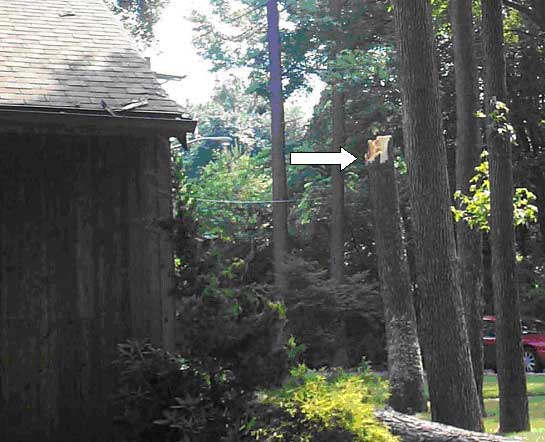 |
|
Fractured Tree # 1
|
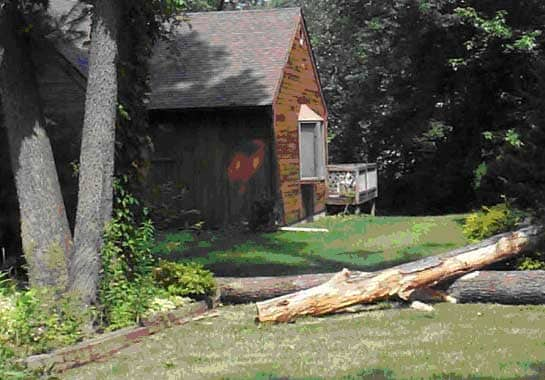 |
|
Fallen Tree Sections Showing Tree Decay
|
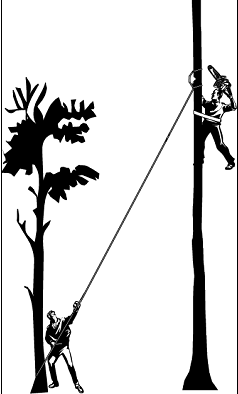
|
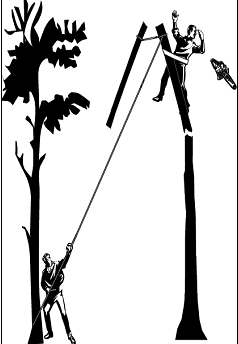
|
|
Tree trimmer in rotted tree, after making the first
notch (face) cut into the tree trunk and applying the timber hitch knot.
|
Tree trimmer after making the back cut
into the tree trunk. |
ATTACHMENTS
American National Standards Institute Z133.1 Revision – October 2000. American National Standards for Tree Care Operations – Pruning, Trimming, Repairing, Maintaining, and Removing Trees, and Cutting Brush – Safety Requirements. October, 2000.
N.J.S.A. 34:6-47.1 et seq., High-Voltage Proximity Act, amended 1987, New Jersey Department of Labor, Division of Workplace Standards, Office of Safety Compliance, P.O. Box 386, Trenton, NJ 08625-0386.
REFERENCES
American National Standards Institute Z133.1 Revision – October 2000. American National Standards for Tree Care Operations – Pruning, Trimming, Repairing, Maintaining, and Removing Trees, and Cutting Brush – Safety Requirements. October, 2000.
NAA Pocket Guide, Identifying Hazard Trees, National Arborist Association, Inc.
3 Perimeter Road, Unit 1, Manchester, NJ 03103
NAA Pocket Guide, Preventing Electrocution, National Arborist Association, Inc.
3 Perimeter Road, Unit 1, Manchester, NJ 03103
NAA Pocket Guide, Preventing Falls, National Arborist Association, Inc.
3 Perimeter Road, Unit 1, Manchester, NJ 03103
N.J.S.A. 34:6-47.1 et seq., High-Voltage Proximity Act, amended 1987, New Jersey Department of Labor, Division of Workplace Standards, Office of Safety Compliance, P.O. Box 386, Trenton, NJ 08625-0386.
To contact New Jersey State FACE program personnel regarding State-based FACE reports, please use information listed on the Contact Sheet on the NIOSH FACE web site. Please contact In-house FACE program personnel regarding In-house FACE reports and to gain assistance when State-FACE program personnel cannot be reached.
|
NJ Department of Health & Senior Services
Occupational Health Service PO Box 360, Trenton NJ 08625-0360 (609) 984-1863
|
|
ATTACHMENT
ANSIZ133.1 Revision-October 2000
Annex D
(Informative)
Available Resources
D.1 Applicable American National Standards
– Z133.1, Arboricultural operations, safety
– A300, Standard practices for trees, shrubs and other woody plant maintenance (publication pending)
– A10.14, Requirements for safety belts, harnesses, lanyards, lifelines, and drop lines for construction and industrial use
– A14.1, Ladders – Portable wood – Safety requirements
– A14.2, Ladders – Portable metal – Safety requirements
– A14.5, Stepladder and platform ladders, aluminum magnesium, fiberglass ladders
– A92.2, Vehicle-mounted elevating and rotating aerial devices
– Z359.1, Safety requirements for personal fall arrest systems, subsystems, and components
– B175.1, Gasoline-powered chain saws, Safety requirements
– Z87.1, Practice for occupational and educational eye and face protection
– Z89.1, Personnel protection – Protective headgear for industrial workers – Requirements
D.2 Applicable Federal Regulations 4
– US Department of Labor – Occupational Safety and Health Administration:
– 29 CFR 1910.000, General Industry
– 29CFR 1910.67, Vehicle-mounted elevating and rotating work platforms
– 29 CFR 1910.95, Occupational noise exposure
– 29 CFR 1910.132-136, Personal protective equipment
– 29 CFR 1910.151, Medical services and first aid
– 29 CFR 1910.268, Telecommunication
– 29 CFR 1010.269, Electric power generation, transmission, and distribution
– 29 CFR 1910.331-335, Safety – Electric-related work practices
– 29 CFR 1910.1200, Hazard communication
– 49 CFR, Transportation
D.3 Training Programs Available from the National Arborist Association 5
– Video programs:
– Professional tree care safety:
– General requirements
– Personal protection
– Equipment procedures
– Operational practices
– Electrical hazards and trees
– Aerial rescue
– Rigging for removal
– Basic training for tree climbers
– Principles of pruning
– Pruning standards
– Chipper use and safety
– Back injury prevention program
– Chain saw selection & maintenance
– Chain saw use and safety
– Ropes, knots and climbing
– Basic training for ground operations in tree care
– Written Programs:
– Home Study Program in Arboriculture – Series I & II
– Crewleader home study program
– Tailgate safety
– Electrical hazards awareness program
– Other publications:
– The treeworker
– Climber’s Guide to Tree Hazards (manual & decals)
– Pocket guide: Preventing falls
– Pocket guide: Preventing electrocutions
– Pocket guide: Preventing struck-by accidents
– Pocket guide: Tree felling guidelines
D.4 Publications Available from the International Society of Arboriculture 6
– Video programs:
– ArborMaster Series I:
– Introduction to Climbing Techniques and Equipment
– Introduction to Secured Footlock: Equipment and Techniques
– Introduction to Ropes: Care, Construction and Limitations
– Introduction to Belay: Equipment and Techniques
– Introduction to Throwline: Equipment and Techniques
– Climbing Knots and Hitches
– Arborimaster Series II:
– Innovations in Climbing Equipment
– Rigging Knots, Rope Slings, and Eye Splices
– ArborMaster Series III:
– Chain Saw Safety
– Chain Saw Maintenance
– Notches, Hinges, and Backcuts
– Felling Techniques
– Limbing and Bucking
– Chain Saw Use in Trees
– Other videos:
– Basic Training for Tree Climbers
– Basic Training for Ground Operations in Tree Care
– Climbing Skills Test Preparation
– Basic Training for Ground Operations in Tree Care
– Conducting a Tree Climbing Jamboree
– Utility Pruning: A Video Guide for Pruning Near Utility Conductors
– Managing Trees for Public Safety: An rborist’s Guide
– Tree Health Management: Evaluating Trees for Hazard
– Written programs:
– Arborists’ Certification Study Guide (English, Spanish and audio cassette)
– Tree Climbers’ Guide
– ArboristEquipment: A Guide to the Tools and Equipment of Tree Maintenance and Removal
– A Handbook of Hazard Tree Evaluation For Utility Arborists
– Trees and Overhead Electric Wires: Proper Pruning & Selection
– A Photographic Guide to the Evaluation of Hazard Trees in Urban Areas
– Tree Pruning Guidelines (English and Spanish)
– Other Publications:
– Spanish-English/English-Spanish Dictionary of Arboricultural Terms
– Tree Climber’s Companion (written and published by Jeff Jepson)
– On Rope (written by Smith and Padgett, published by National Speleological Society)
D.5 Other Publications
– ACRT Line-Clearance Tree Trimmer Certification Manual, Revision 1996 7
– ACRT Electric Hazard Recognition Certification Manual 7
– ACRT Electric Hazard Recognition for Substation Grounds Maintenance Personnel and Herbicide Applicators Certification Manual 7
– US Department of Agriculture – US Forest Service Job Corps Urban Forestry Student Activity Guide 7
– ACRT Working in Trees – Self Study Program 7
– Pruning Trees Near Electric Utility Lines 8
4 All Available from the U.S. Department of Labor, OSHA, 200 Constitution Avenue, NW, Washington, DC 20201
5 All available from the National Arborist Association, 3 Perimeter Road, Unit 1, Manchester, NH 03103
6 All available from the International Society of Arboriculture, P.O. Box 3129, Champaign, IL 61826-3129(www.isa-arbor.comexternal icon )
7 All available from ACRT, Inc., Utility Forestry Specialist, P.O. Box 401, 2545 Bailey Road, Cuyahoga Falls, OH 44221-0401, (800) 622-2562, http://www.acrtinc.com/external icon (Link updated 4/4/2013)
8 Published by Shigo and Trees Associates, 4 Denbow Road, Durham, NJ 03824, (603) 868-7459
Reprinted with permission, International Society of Arboriculture
ATTACHMENT
New Jersey High Voltage Proximity Act
New Jersey Permanent Statutes
TITLE 34 LABOR AND WORKMEN’S COMPENSATION
34:6-47.1. Definitions
As used in this act:
a. “Commissioner” means the Commissioner of Labor or any of his authorized representatives.
b. “High-voltage lines” means electrical conductors installed above ground and having a voltage differential in excess of 750 volts between any pair of conductors or between any conductor and ground. In the case of alternating current, the voltage shall be measured in R.M.S. value. This definition shall not include approved armored cable used to supply power to portable equipment and insulated power cables enclosed in approved metallic raceways.
L. 1948, c. 249, s. 1; amended by L. 1966, c. 251, s. 2; 1987, c. 124, s. 1.
34:6-47.2. Prohibited activity
No employer or supervising agent of an employer shall require or permit an employee to participate in the operation, erection, transportation, handling, or storage of any tools, machinery, equipment, supplies, materials, or apparatus or the moving of any building, if in the course of such operation, erection, transportation, handling, storage or moving it is possible for such tools, machinery, equipment, supplies, materials, apparatus or building, to come within 6 feet of a high-voltage line; or to participate in any activity which would cause the employee to come within 6 feet of a high-voltage line; unless precautionary action has been taken to protect against the danger from contact with such high-voltage line, either by de-energizing such high-voltage line and grounding it where necessary, or other effective methods or devices which have been approved in advance by the commissioner for the particular case and for the particular location.
No person shall operate, erect, transport, handle or store any tools, machinery, equipment, supplies, materials or apparatus, or move any building, if in the course of such operation, erection, transportation, handling, storage or moving, it is possible for such tools, machinery, equipment, supplies, materials, apparatus or building, to come within 6 feet of a high-voltage line unless precautionary action has been taken to protect against the danger from contact with such high-voltage line either by de-energizing such high-voltage line and grounding it where necessary, or by using other effective methods or devices which have been approved in advance by the commissioner for the particular case and for the particular location.
In no case shall the required 6 foot clearance be provided by moving or displacing any conductor, except where the same is temporarily relocated pursuant to arrangements made with the owner or person in charge of the high-voltage line.
L.1948, c. 249, p. 1100, s. 2. Amended by L.1966, c. 261, s. 3.
34:6-47.4. Warning sign required
The owner, agent, lessee, bailee, user, or employer responsible for the operations of equipment capable of coming in contact with a high-voltage line in the course of its operation, shall post and maintain in plain view of the operator on each piece of such equipment, an approved durable warning sign legible at a distance of 12 feet reading “Unlawful to operate this equipment within 6 feet of high-voltage lines”. The owner, agent, lessee, bailee, user, or employer responsible for the operations of equipment shall provide such other warning signs on equipment or at the work site as may be required by regulations promulgated hereunder. The requirement that warning signs be posted shall not apply to railway equipment operating on railway right-of-way in relation to high-voltage conductors of such railway system under conditions for which
exemption is granted under section 8 of this act.
L.1948, c. 249, p. 1101, s. 4. Amended by L.1966, c. 261, s. 4.
34:6-47.5. Notification to power company and responsibility for safeguards
Whenever any activity is to be performed requiring precautionary action under section 2 of this act, the employer, contractor or other person responsible for the activity shall, promptly notify the owner or person in charge of the high-voltage line of the intended activity and shall fully comply with and shall be responsible for the cost and for the
completion of the precautionary action required under section 2 of this act before proceeding with such activity.
L.1948, c. 249, p. 1102, s. 5. Amended by L.1966, c. 261, s. 5.
34:6-47.6. Enforcement
The commissioner shall administer and enforce the provisions of this act and he is hereby empowered to prescribe and promulgate rules and regulations consistent herewith.
L.1948, c. 249, p. 1102, s. 6.
34:6-47.7a. Penalty for violation
6. Any person violating any of the provisions of P.L.1948, c.249 (C.34:6-47.1 et seq.) shall be liable to a penalty of not less than $500.00 nor more than $5,000.00 to be collected in a civil action by a summary proceeding under “the penalty enforcement law” (N.J.S.2A:58-1 et seq.). Any violation of P.L.1948, c.249 (C.34:6-47.1 et seq.) by an officer, agent or employee shall also be a violation of P.L.1948, c.249 (C.34:6-47.1 et seq.) by his employer if such employer had knowledge of and actual control over the cause of such violation. Where the violation is of a continuing nature each day during which it continues, shall constitute an additional, separate and distinct offense. Any sum collected as a fine or penalty pursuant to this section shall be applied toward enforcement and administration costs of the Division of Workplace Standards in the Department of Labor.
The commissioner is hereby authorized and empowered to compromise and settle any claim for a penalty under this section in such amount in the discretion of the commissioner as may appear appropriate and equitable under all of the circumstances.
L.1966,c.261,s.6.; amended 1987,c.124,s.3; 1991,c.205,s.23.
34:6-47.8. Exceptions
This act shall not be construed as applying to, shall not apply to, and is not intended to apply to, the construction, reconstruction, operations, and maintenance of overhead electrical conductors and their supporting structures and associated equipment by authorized and qualified electrical workers; nor to the authorized and qualified employees of any person engaged in the construction, reconstruction, operation, and maintenance of overhead electrical circuits or conductors and their supporting structures and associated equipment of rail transportation systems, or electrical generating, transmission, distribution, and communication systems. This exception when applied to railway systems, shall be construed as permitting operation of standard rail equipment, which is normally used in the transportation of freight or passengers or both and the operation of relief trains, or other equipment in emergencies, or in maintenance of way service, at a distance of less than 6 feet from any high-voltage conductor of such railway system; but this act shall be construed as prohibiting normal repair or construction operations at a distance of less than 6 feet from any high-voltage conductor by other than properly qualified and authorized persons or employees under the direct supervision of an authorized person who is familiar with the hazards involved, unless there has been compliance with the safety provisions of section 2, 4, and 5 hereof.
This act shall not be construed as applying to, shall not apply to and is not intended to apply to, motor vehicle transportation across or along a public road or highway where such transportation is subject to the requirements of Title 39, Motor Vehicles and Traffic Regulation of the Revised Statutes, nor to motor vehicle transportation subject to the requirements of P.L.1952, chapter 16, page 65, section 1 et seq., New Jersey Highway Authority or P.L.1948, chapter 454, page 1856, section 1 et seq., New Jersey Turnpike Authority.
L.1948, c. 249, p. 1102, s. 8. Amended by L.1966, c. 261, s. 7, eff. Sept. 6, 1966.
34:6-47.9. Partial invalidity
In case any provision of this act shall be adjudged unconstitutional or void for any reason, such adjudication shall not affect any of the other provisions of this act.
L.1948, c. 249, p. 1103, s. 9.
34:6-67.2. Application of chapter
Whenever, in the chapter to which this act is a supplement, reference is made to a factory, to a workshop, or to a place where the manufacture of goods of any kind is carried on, it shall be presumed, unless the context of the particular section in which it appears expressly states to the contrary, that said words or phrases, or any of them, refer, among other things, to newspaper plants, in which newspapers are printed or published, and to any place in which persons are employed in the printing or publishing industry. Said newspaper plants and other places in which persons are employed in the printing or publishing industry are expressly included within the terms and provisions, the requirements and prohibitions contained in said chapter 6 of Title 34, wherever reference is made to any factory, workshop, mill or other place where the manufacture of goods is carried on, except where the context of the particular section of said chapter expressly states to the contrary.
L.1962, c. 192, s. 1.
Back to New Jersey FACE reports
Back to NIOSH FACE Web
